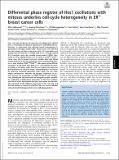Files in this item
Differential phase register of Hes1 oscillations with mitoses underlies cell-cycle heterogeneity in ER+ breast cancer cells
Item metadata
| dc.contributor.author | Sabherwal, Nitin | |
| dc.contributor.author | Rowntree, Andrew | |
| dc.contributor.author | Marinopoulou, Elli | |
| dc.contributor.author | Pettini, Tom | |
| dc.contributor.author | Hourihane, Sean | |
| dc.contributor.author | Thomas, Riba | |
| dc.contributor.author | Soto, Ximena | |
| dc.contributor.author | Kursawe, Jochen | |
| dc.contributor.author | Papalopulu, Nancy | |
| dc.date.accessioned | 2021-11-03T13:30:08Z | |
| dc.date.available | 2021-11-03T13:30:08Z | |
| dc.date.issued | 2021-11-09 | |
| dc.identifier | 276536473 | |
| dc.identifier | 6c1f311b-721e-4d8c-bfb8-bf01b0b134d7 | |
| dc.identifier | 85119252903 | |
| dc.identifier | 000720926500011 | |
| dc.identifier.citation | Sabherwal , N , Rowntree , A , Marinopoulou , E , Pettini , T , Hourihane , S , Thomas , R , Soto , X , Kursawe , J & Papalopulu , N 2021 , ' Differential phase register of Hes1 oscillations with mitoses underlies cell-cycle heterogeneity in ER + breast cancer cells ' , Proceedings of the National Academy of Sciences of the United States of America , vol. 118 , no. 45 , e2113527118 . https://doi.org/10.1073/pnas.2113527118 | en |
| dc.identifier.issn | 0027-8424 | |
| dc.identifier.other | Bibtex: Sabherwale2113527118 | |
| dc.identifier.other | ORCID: /0000-0002-0314-9623/work/102725994 | |
| dc.identifier.uri | https://hdl.handle.net/10023/24252 | |
| dc.description | The work was sponsored by the Wellcome Trust Grant 106185/Z/14/Z (to N.P.). | en |
| dc.description.abstract | Here, we study the dynamical expression of endogenously labeled Hes1, a transcriptional repressor implicated in controlling cell proliferation, to understand how cell-cycle length heterogeneity is generated in estrogen receptor (ER)+ breast cancer cells. We find that Hes1 shows oscillatory expression with ∼25 h periodicity and during each cell cycle has a variable peak in G1, a trough around G1–S transition, and a less variable second peak in G2/M. Compared to other subpopulations, the cell cycle in CD44HighCD24Low cancer stem cells is longest and most variable. Most cells divide around the peak of the Hes1 expression wave, but preceding mitoses in slow dividing CD44HighCD24Low cells appear phase-shifted, resulting in a late-onset Hes1 peak in G1. The position, duration, and shape of this peak, rather than the Hes1 expression levels, are good predictors of cell-cycle length. Diminishing Hes1 oscillations by enforcing sustained expression slows down the cell cycle, impairs proliferation, abolishes the dynamic expression of p21, and increases the percentage of CD44HighCD24Low cells. Reciprocally, blocking the cell cycle causes an elongation of Hes1 periodicity, suggesting a bidirectional interaction of the Hes1 oscillator and the cell cycle. We propose that Hes1 oscillations are functionally important for the efficient progression of the cell cycle and that the position of mitosis in relation to the Hes1 wave underlies cell-cycle length heterogeneity in cancer cell subpopulations. | |
| dc.format.extent | 12 | |
| dc.format.extent | 2898268 | |
| dc.language.iso | eng | |
| dc.relation.ispartof | Proceedings of the National Academy of Sciences of the United States of America | en |
| dc.subject | Hes1 | en |
| dc.subject | Cell cycle | en |
| dc.subject | Oscillations | en |
| dc.subject | Nongenetic heterogeneity | en |
| dc.subject | Cancer stem cell fate | en |
| dc.subject | QH301 Biology | en |
| dc.subject | DAS | en |
| dc.subject | SDG 3 - Good Health and Well-being | en |
| dc.subject.lcc | QH301 | en |
| dc.title | Differential phase register of Hes1 oscillations with mitoses underlies cell-cycle heterogeneity in ER+ breast cancer cells | en |
| dc.type | Journal article | en |
| dc.contributor.institution | University of St Andrews. Applied Mathematics | en |
| dc.identifier.doi | https://doi.org/10.1073/pnas.2113527118 | |
| dc.description.status | Peer reviewed | en |
This item appears in the following Collection(s)
Items in the St Andrews Research Repository are protected by copyright, with all rights reserved, unless otherwise indicated.

